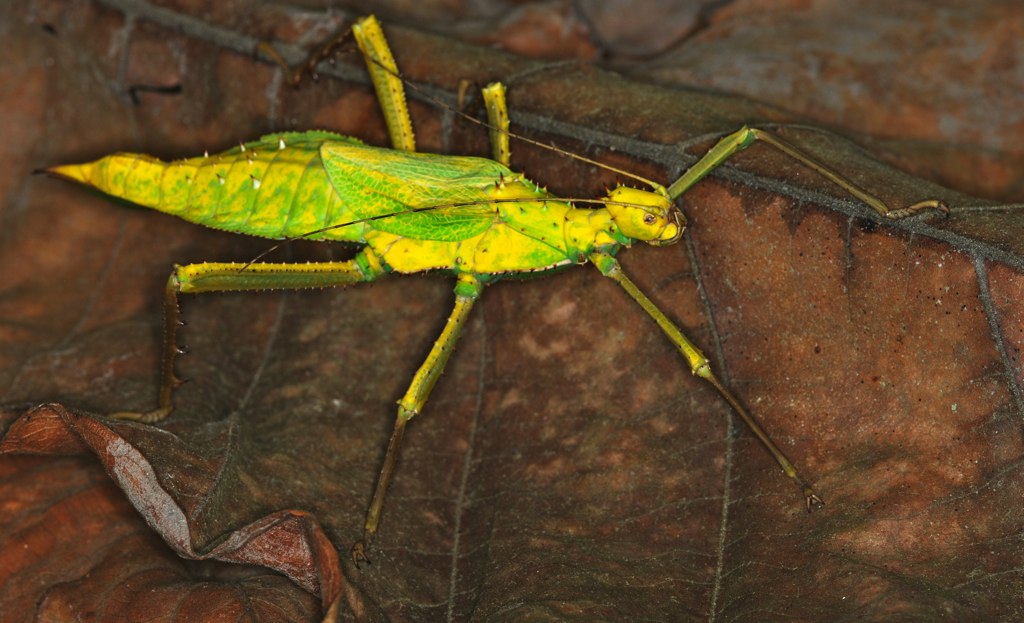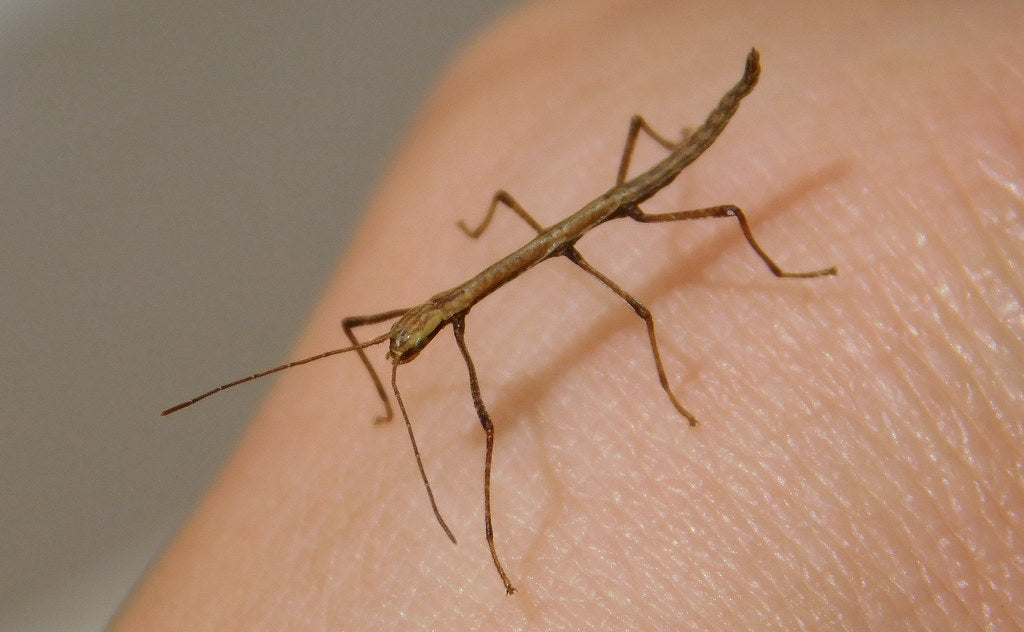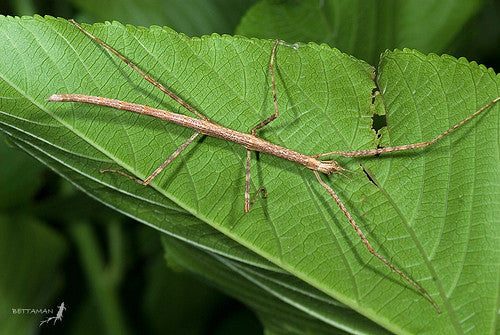The jungle nymph (Heteropteryx dilatata) is also known as the Malaysian stick insect. It is a large, nocturnal, herbivorous invertebrate primarily native to Malaysia. Its preferred habitat is tropical forest.
Jungle nymphs are generally between 3.5-6” long, with females being significantly larger than males. Some females have been known to get larger than 6”. Aside from size, mature males and females also differ significantly in general appearance. Females are lime green or bright yellow with a wide, heavy body, while males are brown/beige and more slender. Females have short, nonfunctional wings, while males have fully-formed, functional wings. Both are covered in small spikes.
Jungle nymphs are popular pets because of their striking appearance, but it’s important to keep in mind that they have more sensitive care needs than average, and tend to be less tolerant of handling. But with good care, they can live up to 2 years.
How much space do jungle nymphs need?
The general rule with housing stick insects is that the enclosure length and width should be at least twice that of the stick insect’s expected adult length, and the height should be at least three times expected adult length. A good starting point is 12”W x 18”H for one. The enclosure should have a mesh top for your pet to hang from for molting, and it should be well ventilated. Full-mesh enclosures work very well in climates that are not particularly dry.
Jungle nymph stick insects can be housed in groups just fine. The important thing to remember for housing groups is that they will need more space, particularly horizontal space.
Do jungle nymphs need special lighting?
As long as the stick insect’s enclosure is in a room that receives ~12 hours/day of artificial or bright natural light, then additional lighting equipment is unlikely to be necessary. However, if it is being kept in a dark room then ~6500K fluorescent or LED illumination is helpful.
Do not place your stick insect’s enclosure in front of a window, as the sunlight can overheat the enclosure and kill your pet!
What temperatures do jungle nymphs need?
Jungle nymphs seem to do best between 77-82°F, so they need to be kept a little above room temperature. Avoid temperatures above 86°F and below 64°F. Keep track of the temperatures inside your enclosure with a digital thermometer like the Zoo Med Digital Thermometer & Humidity Gauge, with the probe placed in the middle.
To warm the enclosure, use a low-wattage white heat lamp. Use a Zoo Med Nano Dome Lamp Fixture with a low-wattage heat bulb like the 25w Zoo Med Nano Basking Spot or similar. Place this in the middle of the enclosure. Do not place the lamp on top of the mesh, as this can burn your pet if it climbs onto the mesh. Instead, suspend the lamp from a Zoo Med Reptile Lamp Stand or similar.
The heat lamp should be turned off every night.
What humidity levels do jungle nymphs need?
Humidity is very important for successfully keeping stick insects as pets, as it helps ensure successful molting and general wellbeing. The jungle nymph requires average humidity levels of around 70% to stay healthy.
To increase and maintain healthy humidity levels, lightly mist your pet’s enclosure with a spray bottle at least every evening. If you are using a mesh rather than glass/plastic enclosure, then you will likely need to spray more heavily and more often. This also gives your pet droplets of water that it can drink.
Humidity levels should be monitored with a Zoo Med Digital Thermometer & Humidity Gauge or similar with the probe placed in the middle of the enclosure.
What substrate is good for jungle nymphs?
Substrate is important to a stick insect setup because it helps maintain healthy humidity levels. It’s best not to go bioactive, as your stick insect will eat the plants down to stubs. Here are some better substrate options:
- Zoo Med Creatures Eco Soil
- Zoo Med Creature Soil
- Zoo Med ReptiBark
- Eco Earth Plantation Soil
- Exo Terra Forest Bark
- Zilla Bark Blend
You don’t need very much substrate. Depending on the size of the enclosure, 1-2” should be plenty.
To keep your stick insect’s enclosure clean, replace the substrate weekly and completely rinse out the enclosure and décor with hot water. Don’t use soap or disinfectants, as the residue may harm your pet!
What décor can you use in a jungle nymph terrarium?
Jungle nymphs like having things to climb and hide amongst in their enclosure. This encourages natural behaviors, which makes them more fun to watch, and decreases stress, which in turn increases lifespan. Here are some ideas:
Climbing objects should be arranged at a variety of angles to give your pet options. Hot glue is excellent for adhering climbing objects and artificial foliage to terrarium walls.
Make sure to leave an open space at the top of the enclosure twice the height of your pet to accommodate molting.
What do jungle nymphs eat?
Stick insects are herbivorous, which means that they eat plants. Jungle nymphs eat leaves from the following plants:
- Blackberry (older leaves only, no new leaves)
- Raspberry
- Oak
- Rose
- Ivy
- Hawthorn
Food should be available every other day — it’s not a good idea to starve your stick insect! It’s best to offer a branch of leaves, placed in a weighted vase of water to keep the leaves fresh for 4-8 days.
Oak leaves freeze well for winter, and blackberry leaves usually stay available throughout winter. If you are having difficulty sourcing appropriate leaves for your stick insect to eat, romaine lettuce can be used in a pinch.
Never use leaves from garden centers or florists, as these are likely to be treated with insecticides that will kill your pet! It’s also best to source leaves from plants located well away from roads, where they get contaminated with chemicals from vehicle exhaust.
Do jungle nymphs like to be handled?
Generally speaking, pet invertebrates don’t like to be handled very much, and jungle nymphs can be a bit violent when they feel threatened. Although they can’t bite, females have very sharp spines on their hind legs, which they will snap together on your skin to pinch hard enough to draw blood.
To handle your pet stick insect, it’s best practice to put on a pair of thin leather gloves first to protect yourself from injury. To reduce the likelihood of startling it, place your hand under its front legs and use your other hand to scoop it up from behind. Be very gentle and let the stick insect come off the branch onto your hand of its own volition — otherwise can get injured!
*This care sheet contains only very basic information. Although it’s a good introduction, please do further research with high-quality sources to obtain additional information on caring for this species.
"Jungle Nymph (Heteropteryx dilatata)" by berniedup is licensed under CC BY-SA 2.0




Leave a comment
This site is protected by hCaptcha and the hCaptcha Privacy Policy and Terms of Service apply.